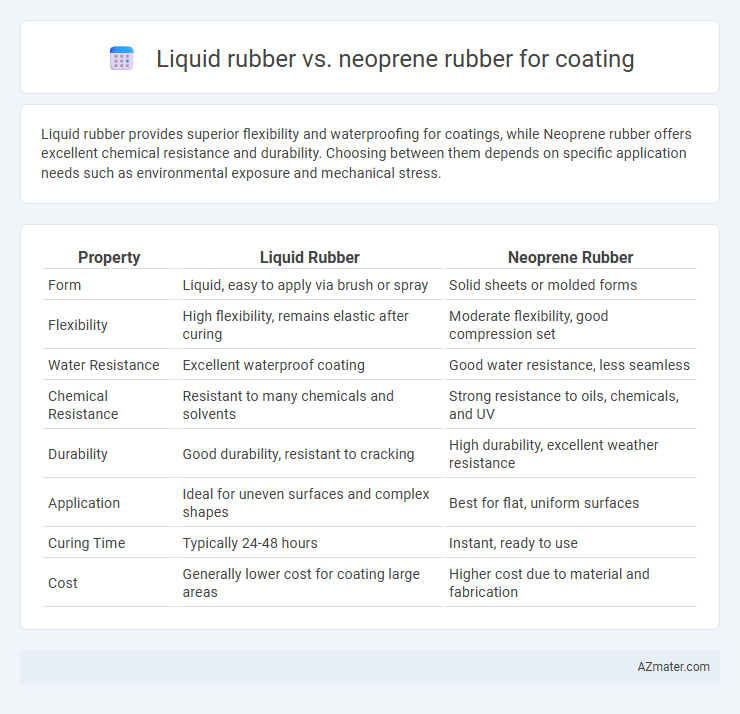Liquid rubber provides superior flexibility and waterproofing for coatings, while Neoprene rubber offers excellent chemical resistance and durability. Choosing between them depends on specific application needs such as environmental exposure and mechanical stress.
Table of Comparison
| Property | Liquid Rubber | Neoprene Rubber |
|---|---|---|
| Form | Liquid, easy to apply via brush or spray | Solid sheets or molded forms |
| Flexibility | High flexibility, remains elastic after curing | Moderate flexibility, good compression set |
| Water Resistance | Excellent waterproof coating | Good water resistance, less seamless |
| Chemical Resistance | Resistant to many chemicals and solvents | Strong resistance to oils, chemicals, and UV |
| Durability | Good durability, resistant to cracking | High durability, excellent weather resistance |
| Application | Ideal for uneven surfaces and complex shapes | Best for flat, uniform surfaces |
| Curing Time | Typically 24-48 hours | Instant, ready to use |
| Cost | Generally lower cost for coating large areas | Higher cost due to material and fabrication |
Introduction: Understanding Liquid Rubber and Neoprene Rubber
Liquid rubber offers a flexible, waterproof coating derived from synthetic polymers, excelling in seamless application and environmental resistance. Neoprene rubber, a chloroprene-based synthetic rubber, is valued for durability, chemical resistance, and abrasion protection in coatings. Both materials serve as protective layers but differ in elasticity, adhesion properties, and suitability for various industrial and marine applications.
Key Differences in Chemical Composition
Liquid rubber is primarily composed of synthetic polymers such as styrene-butadiene or nitrile-based compounds, offering excellent flexibility and waterproofing properties. Neoprene rubber, a chloroprene-based polymer, provides enhanced chemical resistance and durability due to its unique chlorine content. The key chemical difference lies in neoprene's chlorine atoms, which impart superior resistance to oils, chemicals, and temperature variations compared to the hydrocarbon backbone of liquid rubber formulations.
Application Methods: Liquid Rubber vs Neoprene Rubber
Liquid rubber is typically applied using spray, brush, or dip coating methods, allowing for seamless coverage and easy adaptation to complex shapes. Neoprene rubber is commonly applied through vulcanization or adhesive bonding, often requiring curing processes and molds for uniform thickness. The application of liquid rubber offers faster curing times and greater flexibility in field applications compared to the more labor-intensive and equipment-dependent methods needed for neoprene rubber coating.
Durability and Longevity Comparison
Liquid rubber coatings offer exceptional flexibility and adhesion, enhancing durability by resisting cracking and peeling under extreme temperature fluctuations. Neoprene rubber exhibits strong chemical resistance and UV stability, contributing to its longevity in harsh environmental conditions. Comparing both, liquid rubber generally provides superior waterproofing and elasticity, while neoprene maintains higher resilience against oils and solvents, influencing the choice based on specific application durability requirements.
Waterproofing Capabilities of Both Materials
Liquid rubber offers superior waterproofing capabilities due to its seamless application and ability to create a flexible, elastic barrier that resists water penetration even when stretched or cracked. Neoprene rubber provides reliable water resistance with inherent chemical stability and durability, making it suitable for prolonged water exposure but may require seams or adhesives that can compromise waterproof integrity. For applications demanding maximum water protection and adaptability to surface irregularities, liquid rubber coatings generally outperform neoprene rubber sheets in maintaining a consistent waterproof seal.
Flexibility and Elasticity Performance
Liquid rubber offers superior flexibility and elasticity for coating applications, adapting efficiently to surface movements without cracking or peeling. Neoprene rubber demonstrates good elasticity but tends to be less flexible under extreme temperature variations, limiting its performance in dynamic environments. The enhanced stretchability and recovery characteristics of liquid rubber make it ideal for coatings requiring prolonged durability and resilience.
Adhesion to Various Surfaces
Liquid rubber exhibits superior adhesion to a wide range of substrates including metal, wood, concrete, and plastic due to its flexible polymer chains and ability to form seamless, durable coatings. Neoprene rubber, while offering good chemical resistance and moderate adhesion, often requires surface preparation and primers to achieve strong bonding on non-porous materials. The enhanced bonding properties of liquid rubber coatings make them ideal for applications requiring long-lasting protective seals on diverse surfaces.
Environmental Resistance: UV, Chemicals, and Weather
Liquid rubber coatings offer superior environmental resistance with excellent UV stability, chemical resistance, and weatherproofing, making them ideal for harsh outdoor applications. Neoprene rubber provides moderate protection against UV and chemical exposure but can degrade faster under prolonged sunlight and extreme weather conditions. For long-term durability, liquid rubber ensures more effective performance in resisting environmental factors compared to neoprene.
Cost-Effectiveness and Maintenance
Liquid rubber coatings offer superior cost-effectiveness due to lower initial application costs and reduced labor requirements compared to neoprene rubber, which typically demands more complex installation. Maintenance of liquid rubber is minimal as it forms a seamless, flexible barrier resistant to cracking and UV degradation, whereas neoprene coatings often require regular inspection and repair due to brittleness and chemical susceptibility. Over the long term, liquid rubber provides greater value by minimizing downtime and replacement expenses, making it a preferred choice for industrial and commercial coatings.
Choosing the Right Rubber Coating for Your Project
Liquid rubber offers superior flexibility and seamless application, making it ideal for irregular surfaces and waterproofing projects, while neoprene rubber provides exceptional chemical resistance and durability under harsh environmental conditions. Selecting the right rubber coating depends on project requirements such as exposure to UV rays, temperature variations, and mechanical abrasion. For outdoor or marine applications, neoprene's resistance to oil and weathering outperforms liquid rubber, which excels in ease of use and quick curing for protective coatings on metal or concrete.

Infographic: Liquid rubber vs Neoprene rubber for Coating
 azmater.com
azmater.com